• Used to group together executable, sequential statements to define new mathematical or logical functions.
• Also used to define bus resolution functions, operators, and conversion functions between data types.
• When defined in a package, the function must be split into a declaration and a body.
Syntax: Function Body
FUNCTION function_name [] RETURN data_type IS
[declarations]
BEGIN
(sequential statements)
END
function_name;
= [CONSTANT] constant_name : constant_type ; or
= SIGNAL signal_name : signal_type ;Where :(FUNCTION DECLARATION)
package - - end
package body - - end
entity – is - - begin - end
architecture –is - - begin- end
block - - begin - end
generate - - begin - end
process - - begin - end
function – is - - begin - end
procedure – is - - begin - end
NOTE: Function Body is NOT allowed inside a Package
Rules :
• The function_name may be an identifier or an operator.
• Functions cannot assign signals or variables defined outside themselves, nor can then contain wait statements.
• A function must execute a return statement.
• Pure functions cannot have side effects - they must do nothing but return a value.
• There can be any number of such parameters (even zero), can only be CONSTANT (default) or SIGNAL (VARIABLES are not allowed).
• Their types can be any of the synthesizable data types (BOOLEAN,STD_LOGIC, INTEGER, etc.).
• No range specification should be included (for example, do not enter RANGE when using INTEGER, or TO/DOWNTO when using STD_LOGIC_VECTOR).
• On the other hand, there is only one return value, whose type is specified by data_type.
REMEMBER THIS !• The return type must be a name; it cannot include a constraint.
• Variables defined inside a function are initialized each time the function is called.
• The declaration and body must conform, i.e. the parameters and return type must be identical between the two.
• The function declaration ends with a ";", whereas the function body has is at the corresponding point in the syntax.
Synthesis :• Each call to a function is synthesized as a separate block of combinational logic.
Example :
FUNCTION f1 (a, b: INTEGER; SIGNAL c: STD_LOGIC_VECTOR)
RETURN BOOLEAN IS
BEGIN
(sequential statements)
END f1;• The function, named f1, receives three parameters (a, b, and c).
• a and b are CONSTANTS (notice that the word CONSTANT can be omitted, for it is the default object), while c is a SIGNAL.
• a and b are of type INTEGER, while c is of type STD_LOGIC_VECTOR.
• Notice that neither RANGE nor DOWNTO was specified.
• The output parameter (there can be only one) is of type BOOLEAN.
information shared by information shared by www.irvs.info














































